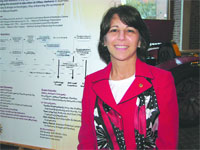
Innovative Force
PMRAP Builds a Bridge Between Research at UMass and Area Manufacturers

Marla Michel says the Precision Manu-facturing Regional Alliance Project has the potential to help existing companies grow market share and add jobs.
Its called the Precision Manufacturing Regional Alliance Project, or PMRAP. Thats the long title of an initiative that one participant, a professor in UMass Amhersts Machining and Industrial Engineering department, called a two-way communication street between the university and area manufacturers. That communication is expected to drive innovation that will eventually lead to growth in a vital sector of the economy and job creation.
There were dozens of area dignitaries gathered at the new Museum of Springfield History for the Dec. 17 press conference to announce an initiative called the Precision Manufacturing Regional Alliance Project, or PMRAP for short.
Many of the speakers, from Springfield Mayor Domenic Sarno to Greg Bialecki, secretary of the state Executive Office of Housing and Economic Development, said the kinds of things one might expect as they discussed the project, funded by a $600,000 National Science Foundation grant.
They used words like historic and breakthrough and potential as they discussed what amounts to a unique partnership between the regions precision-manufacturing sector, departments at UMass Amherst, and other players, designed to foster innovation and create jobs.
But when the owners of these precision manufacturers and officials at UMass spoke, there was a different, very confident tone that wasnt speculative in nature, noted Dave Cruise, project manager for the Regional Employment Board of Hampden County, who was one of those in attendance.
And there was good reason for that, said Cruise, one of the lead coordinators of the PMRAP project. Its because they know that this is not just talk. They can tell that its going to work. Theyve seen it.
Indeed, while those representing the various parties involved in the project waited until the circumstances were right and all the major players could be assembled to stage the elaborate announcement ceremony and signing of a memorandum of agreement, the work toward forging partnerships was already well underway.
It started in late summer with the first of four so-called technology-innovation forums, said Cruise, referring to sessions at which area precision-manufacturing shop owners meet with faculty members at UMass to discuss ways in which they can help each other. These forums had titles ranging from Non-metallic Metals Machining and Processing Technologies to Manufacturing Process Optimization; from Metals and Composite Interfaces to Cryogenic Machining.
The common denominator in each case, said Cruise, was open dialogue designed to develop ways in which research at UMass could help area manufacturers create new products; develop new, more efficient processes; or use lighter and stronger materials to better serve customers and drive innovation.
Marla Michel, director of Research Liaison & Development at UMass, put things another way. She said the innovation forums and the PMRAP as a whole were blueprinted to create what she called an invisible new climate in which technology can be transferred from the labs at the university to plants across the Valley.
Elaborating, she said that UMass faculty members and students are involved in many different types of research projects, and are conducting such work mostly unaware of how it might be applied by small and mid-sized precision manufacturers. Meanwhile, these same manufacturers are facing both challenges and opportunities with regard to existing markets and possible new ones, and without much of an understanding about how ongoing research at UMass might help them accomplish stated goals.
The PMRAP was conceived to essentially open up the lines of communication, keep them open, and build a bridge between a still-strong sector of the economy and one of the states leading research institutions, said Sundar Krishnamurty, a professor in the universitys Mechanical and Industrial Engineering (MIE) department, one of two that are closely involved with the project.
I think this is a very unique opportunity for us to collaborate with small and medium-sized manufacturing facilities, he said. Our valley is known for its manufacturing expertise, but nevertheless, industry on the whole, and especially in Western Mass., is being challenged by increased competition globally, aging facilities and technologies, and insufficient labor.
Krishnamurty said the PMRAP is unique in that it is focusing on smaller precision manufacturers, and also on innovation that will take place in a few years, not 10 or 20, as is the case with most such initiatives. Therefore, it has strong potential to become a model for other regions and universities, he said, noting that there are already some presentations being planned for a year from now, at which PMRAP participants will discuss how their work can be emulated.
More importantly, though, he said, the project could foster job growth, help area companies maintain market share, and increase market share.
Material Evidence
The essence of the PMRAP can be derived from language in the memorandum of agreement between the three major players the Western Mass. Chapter of the National Tooling and Machining Assoc., UMass Amherst, and the REB and specifically from some of the passages pertaining to what UMass effectively agrees to do:
Collaborate in the design and implementation of the Technology Innovation Forums that will result in identifying solution approaches to short- and long-term technology-development issues;
Agree to support small precision-manufacturing companies in their applications for new funds to further the technology transfer between them and UMass; and
Breaking down these assignments and those given to the other parties involved, Cruise said it all comes back to one word: partnerships. And in that respect, the PMRAP is a perfect followup to other work being funded by a John Adams Innovation Institute Grant to make the regions precision-manufacturing sector more visible, a better alternative for job seekers, and, ultimately, more competitive.
Ed Leyden, president of Ben Franklin Design & Manufacturing in Agawam and current president of the Western Mass. Chapter of the National Tooling and Machining Assoc. (NTMA), said that one of the main goals of the Innovation Institute-funded initiative is to drive transfer of technology from UMass to area precision-manufacturing shops; the PMRAP will essentially piggyback that effort and ensure that such transfers take place.
And by doing so, it will keep technology that has historically gone elsewhere inside the Commonwealth and, specifically, the 413 area code.
What excites me about this is that theres so much money being spent on research and development in this state, including that $1 billion set aside for life sciences, he said, and my big question is, why arent we bringing those things to market, why arent we creating jobs in this state? Were doing the research and development here, and then its leaving.
How difficult is it for us to get together, he continued, and keep it here, and create good quality jobs in the process?
The PMRAP project will help change that equation, said Cruise, adding that the initiative has a number of partners. In addition to the REB and UMass, the Economic Development Council of Western Mass., Springfield Technical Community College, Holyoke Community College, and six area vocational technical high schools are all involved.
There are several goals and deliverables, he continued, including the far-reaching ambition of establishing something that would be called the Massachusetts Center for Advanced Precision Manufacturing Technology, which would take all of the PMRAPs stated goals and strategies for reaching them to a higher plane.
The initiative falls under the broad category of economic development, said Michel, and, more specifically, an emerging focus on the state level to help existing companies to not only stay in business but also identify ways to trigger growth and penetrate new markets.
In previous years, theres been a lot of attention put on attracting new businesses here, she explained. But theres been this revival, or aha moment, that we have to make sure that the companies that are already here stay here, and grow. Theres actually been some data that shows that most of the business growth comes from companies that are already here anyway. So why not put some resources there?
If the project takes the course organizers believe it will, then there will be several winners emerging from the work done, Michel continued, noting that precision manufacturers win because they gain new business; researchers at UMass win because they get new and interesting problems to solve, and thats their lifeblood; and the region wins because it gains jobs (in all likelihood), and an important sector becomes more vibrant.
Parts of the Whole
What the PMRAP does is allow small- to medium-sized manufacturers to step beyond the daily grind of survival and look at new-product discovery and development and new and better ways of doing things, Michel told BusinessWest.
What we know is that most of these businesses are looking day to day, how to meet the next order, how to find the next customer, she explained, and not necessarily looking at how to find the next process or how to find the next new material so we can find a different customer and grow our customer base.
Thats one of the really neat things that this project is doing, she continued, using the present tense as she did so. Its allowing companies to learn about new technologies before they have customers with them, and so they can find customers with them. But its also allowing the faculty, the researchers, to see how the technology is used in an environment like this, as opposed to with a larger company or in a research environment.
Krishnamurty agreed, and said the main goal of the PMRAP is to create what he called a two-way communications street whereby those in the precision manufacturing industry and faculty and students at UMass can get together and discuss new and innovative ideas.
And not in a generic sense, but in targeted, tailored research projects, he said, ones that will likely have an immediate impact. A lot of the work that goes on at universities is futuristic looking 10 or 20 years down the road and assessing how we can change things. But with this particular project, our focus is on more immediate transfer of applications.
This, in essence, is what the technology-innovation forums are all about.
Michel says she hasnt been to any of the innovation forums, but shes received enough feedback from those who have to gain a real sense of whats happening at these events and why the exchanges bode well for the future.
She described the sessions as elaborate mating dances of sorts, during which the two main parties (the MIE and Polymer Science Engineering departments at UMass and representatives of area precision manufacturers), as well as other partners, gauge compatibility and the ability to understand each others language. Most have gone well, but one that got off to a rather slow start showed and perhaps better than the others how these are going to work.
The fourth session [Cryogenic Machining, or the use of liquid nitrogen to cool tools] looked like it was going to be a total dud, Michel explained. People were getting ready to wrap up and say, this is not working we dont have anything here, but then, someone said something, and things just started flowing.
Krishnamurty, who was one of several from the MEI Department in attendance for that session, said it was slow to yield some true results, but eventually, the give-and-take led to discussions that might eventually lead to process improvements that could improve efficiency for many area shops.
Cryogenic manufacturing eliminates the need for many other kinds of cooling processes, and reduces the general wear and tear on the tools, he explained. The challenge is how to bring the liquid nitrogen into the plant in what shape and form does the process take, and how does it affect the machining operation?
Our hope and hypothesis is that it will lead to significant improvement in efficiency and cost-effectiveness for our partners, he continued, adding that discussions on this subject will definitely continue.
Similar developments should be expected from the other forums, both those already held and two additional ones slated for early this year, said Krishnamurty, noting that the sessions have yielded what he called very good exchanges.
These have been very conversational discussions on what our priorities should be moving forward, he explained. What projects are of interest to them, and what are the projects with which UMass can make the maximum contribution? We heard from the companies about their needs, and we heard from the faculty about their expertise.
In so doing, he concluded, the sessions helped break down what one area shop owner called a wall between the university and the manufacturing sector.
Finished Product
Several of those who spoke at the Dec. 17 press conference talked about how the history museum was the perfect setting to announce the PMRAP. Most all of the exhibits in the facility, which opened only a few months ago, are prime examples of how innovation changed everyday life and fueled the regions economy.
Those in attendance were given a tour that included exhibits of Rolls Royces made in Springfield, Indian Motocycles that were invented in the City of Homes, Smith & Wesson guns, and some products made by current precision manufacturers spawned by what many consider the age of innovation in the the Pioneer Valley.
No one can say with any degree of certainty when or if the PMRAP project will add to the exhibits in the museum. But what all those involved do know is that this initiative has enormous potential for making the precision-manufacturing sector more vibrant and a bigger force in economic development.
They know, because theyve already seen it.
George OBrien can be reached at[email protected]




